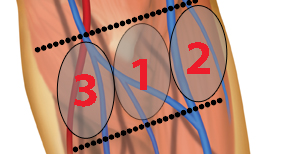Eight Questions Every Phlebotomist MUST Answer Correctly: #4
Do you prioritize veins according to risk?
by Dennis Ernst • March 23, 2021

Question: Do you draw from the first vein you find to hasten the procedure?
If so, there is a provision in the standards you could be ignoring at the expense of your patient, and making your employer liable for an injury. From now on, prioritize the veins for safety.
Depending on where they're located, some veins carry a higher risk of arterial and nerve injury than others. That's why the standards say to conduct a thorough survey of available veins from both arms and select the one that brings the greatest degree of confidence that it can be successfully accessed with the lowest risk of injury.
Which area of the antecubital area is the riskiest? The area where the basilic vein is located, i.e., on the inside or medial aspect of the antecubital area. If you extend your arm outward with your palm facing up, the medial aspect is on the pinky side of the antecubital (#3 in the illustration). If you feel there for a pulse, you're close. If it's the first vein you see on a patient, look elsewhere. The standards insist. Not only is the nearby brachial artery at risk of being punctured should you miss your mark, but two tracts of the median antebrachial cutaneous nerve take up residence in the same area. Should your needle strike one of them, your patient could feel excruciating, electric-like pain, and suffer permanent nerve injury.
Prioritizing veins for safety, then, means selecting either of the other areas of the antecubital area where veins are commonly found (i.e., the median or cephalic) before drawing from the higher-risk basilic vein. The CLSI venipuncture standard suggests this priority:
- veins in the median aspect (middle of the antecubital area);
- veins in the lateral aspect (outer, furthest from the torso);
- veins in the medial aspect (inner, closest to the torso).
Therefore, draws from the basilic vein, or the medial aspect of the median cubital vein, should only be considered if no other veins are more prominent on either arm. That means all draws require a tourniquet. Without one, prioritizing veins for safety cannot be accomplished.
Correct answer: I only draw from the area of the basilic vein when I don't have confidence that there is a vein in the median or cephalic area in either arm that I can access safely and successfully.
If you can't wait to get the next four questions, I've compiled all eight into one of our most popular downloads, "Eight Questions Every Phlebotomist Must Answer Correctly."
BLOGGER'S NOTE: electronic and hard copies of CLSI's venipuncture standard as well as a poster depicting the anatomy of the antecubital area can be obtained from the Center for Phlebotomy Education's web site.
Related Posts and Information
overall rating: my rating: log in to rate
anatomy antecubital blood draw brachial cephalic median cubital nerve injury
